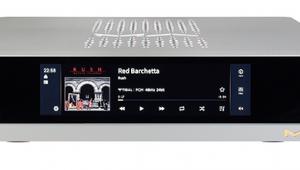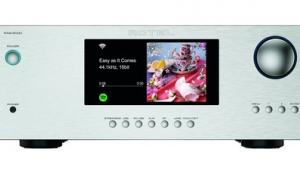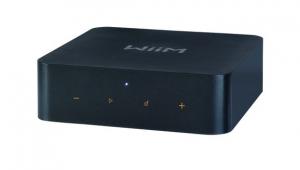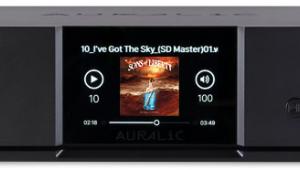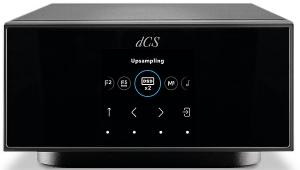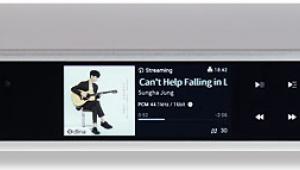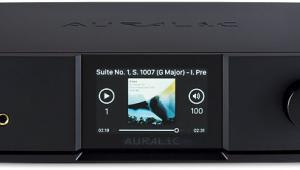Marantz Model M1
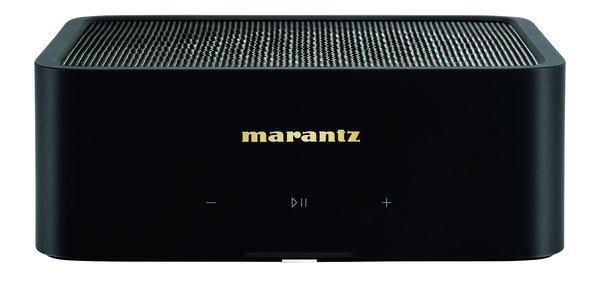
 With HEOS built-in, and support for numerous streaming services, Marantz's bijou Model M1 network-attached amplifier pulls off a blend of minimalism with supreme flexibility
With HEOS built-in, and support for numerous streaming services, Marantz's bijou Model M1 network-attached amplifier pulls off a blend of minimalism with supreme flexibility
To some readers, the Model M1 might appear an unusual product to carry the Marantz moniker. After all, for the last few years the brand has positioned itself in the premium sector, with amplifiers like the Model 30 and Model 40n . This, however, discounts the existence of various Marantz Melody mini systems over the years and, more importantly, the perceived need to counter the surge in popularity of soundbars. The (now) £1800 Model 40n was a first step in that direction, adding an HDMI ARC input to a more traditional amplifier. But that's still a relatively expensive piece of hardware, at least for someone otherwise considering a soundbar. The Model M1, at £900, closes that gap and is compact to boot.
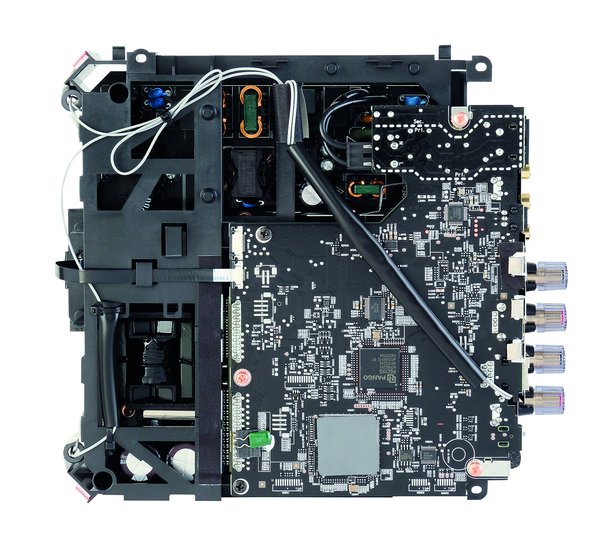 A nest of carefully screened PCBs within
the M1 is surrounded by switchmode PSUs [top
and left] with Pango CPLD and TI PCM9211
digital transceiver (inc. ADC) on the top PCB and
Axign/TI digital Class D amp underneath
A nest of carefully screened PCBs within
the M1 is surrounded by switchmode PSUs [top
and left] with Pango CPLD and TI PCM9211
digital transceiver (inc. ADC) on the top PCB and
Axign/TI digital Class D amp underneath
Hide And Seek
With this unit, Marantz is also entering a very busy market segment - small-form streaming amplifiers with multiroom capabilities. How busy? Well, next to various dedicated custom install (CI) products, there's the Sonos Amp, two iterations of Bluesound's Powernode, Harman Kardon's Citation Amp and the recently launched Loewe multi.room.
All are extremely similar: small boxes, usually finished in black and using Class D amplification, with integrated streaming and HDMI ARC connectivity. They're designed to appeal to people looking for something to drive loudspeakers in their living room, while the amp itself remains invisible - hidden in AV furniture or behind a TV. Another use might see them racked by CI installers in a boot room to power in-ceiling or in-wall speakers.
All of this perfectly describes the M1 with its claimed 100W output [see PM's Lab Report, p59] and features to tempt both regular consumers and installers alike. For example, the latter will appreciate the ability to fit a pair neatly into a standard 19in rack (extra clips are available), the Model M1's mono mode (very handy for in-ceiling use), and integration with control platforms including Crestron, Control4 and AMX. The strength of the custom install market also explains Marantz's new M4, a rack-mounted four-zone/eight-channel streaming amplifier.
Dust Off A Remote
Par for the course, the Model M1 is matt black and shoebox-sized. It's nicer to behold (and touch) than most rivals though, with a soft-touch finish brandishing a shiny gold Marantz logo - but be prepared to dust it regularly. The top of the amplifier features a black metal grille, with a 'wavy' structure that assists with EMI/CE approval and looks good too. On the front, below the logo, are just three illuminated touch buttons, allowing for volume control and track play/pause/skip functions.
All other operations are governed by the HEOS app [see boxout, p57] or a remote control. No handset is supplied but you can dig out an old IR remote and get the M1 to learn its commands, relinking them to desired functions via the app. This includes on/off as there's no physical button on the M1, just two levels of standby. And, of course, when connected to a TV over HDMI ARC, volume/power changes are relayed via HDMI CEC.
The M1 is a streaming amplifier first and foremost, with multiple options to play music from a smartphone or tablet. Leading the way here is the built-in HEOS platform, which lets you partner the M1 with wireless speakers (and more) from Marantz and Denon, among others. Any additional HEOS components appear as a different room or zone in the HEOS app (in my case, both a Marantz Stereo 70s receiver and a Denon AVC-A1H multichannel AV amp showed up).
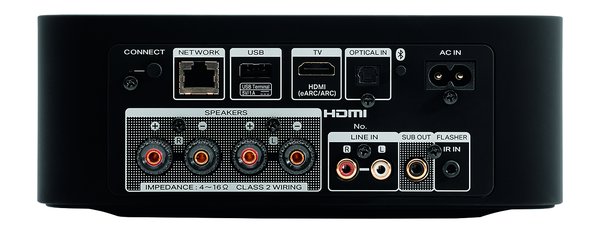 Wi-Fi and BT pairing buttons flank Ethernet (192kHz/DSD128 and control),
USB-A (for external drives), HDMI (eARC, for TV connection) and optical (96kHz/24-bit)
digital ins. Analogue line in, sub out and 4mm speaker cable connections are below
Wi-Fi and BT pairing buttons flank Ethernet (192kHz/DSD128 and control),
USB-A (for external drives), HDMI (eARC, for TV connection) and optical (96kHz/24-bit)
digital ins. Analogue line in, sub out and 4mm speaker cable connections are below
Go Your Own Way
The app is fairly straightforward to use, especially when playing your own music files from USB storage slotted into the back of the M1, or via a NAS device. It offers broad file format compatibility, handling PCM to 192kHz/24-bit and DSD128, and there are a few music services integrated - Tidal, Amazon Music and Soundcloud being the headliners. More are promised, but that's been said for years now, so note that Apple AirPlay 2, Bluetooth and Spotify Connect give you alternative ways to play other services. It's DLNA compatible as well, so you can stream from apps such as mConnect or BubbleUPnP.
If you want to get physical, the M1 has an analogue input (on RCAs) to connect a CD player or phono preamp, while optical digital in and HDMI ARC are there for TV duties. When it comes to networking, choose between Wi-Fi or Ethernet.
Made To Fit
Under the hood, this amp's electronics are bunched together with layers of PCBs and cables leading off to wireless antennas on the inside front corners of the case [see pic, p56], making it challenging for PM to open and investigate. (The amp is a marriage of Axign's AX5689 digital Class D amplifier controller with the power stage from Texas Instruments' DRV8932 quad half-bridge driver chip.) Remarkably, the relatively affordable M1 is built at the Shirakawa Audio Works facility in Japan, normally reserved for top-tier products from Marantz and Denon.
Model Citizen
There's no complex system building required here. Hooking up a pair of Q Acoustics 5040 floorstanders - the smaller version of the 5050 and tending to a more even-handed representation - was a doddle. Marantz offers excellent graphical 'Setup Assistants' on its AV receivers, and a condensed version is present in the HEOS app to help you get the Model M1 up and running.
While Mick Harvey is best known for underpinning Nick Cave's crooning in The Bad Seeds, and for creating some superb songs with PJ Harvey, last year's Phantasmagoria In Blue [Mute CDSTUMM493] saw him teaming up with Amanda Acevedo. The album, at first created by exchanging music files across the Internet, features a cover of 'Indian Summer' in English and Spanish, which the M1 played in a suitably languid manner. For someone who grew up listening to Serge Gainsbourg on the radio, it sounded very familiar, Marantz's compact amplifier offering an organic warmth that conveyed a dreamy atmosphere - a sound which isn't miles away from that of the brand's full-sized components.
However, I did feel the need to attenuate the treble very slightly (there are tone controls in the HEOS app - see screenshot, left) although whether the Class D Model M1 was finding the 5040's tough HF load troublesome was tricky to say. Either way, some adjustment helped make 'Song To The Siren', later on the album, a more suitable tribute to earlier versions by Tim Buckley and This Mortal Coil, with Acevedo's singing appearing full-bodied next to Harvey's more slender vocals. And although the soundstage didn't open up enormously, I appreciated how the M1 put appropriate emphasis on the vocals, generating an emotional connection.
Culture Vulture
With her new Night Reign, the US-based Pakistani artist Arooj Aftab has released another remarkable album, but it is the older, more serene Vulture Prince [New Amsterdam Records; 96kHz/24-bit] that saw her becoming truly favoured by music buffs who adore mashups of Asian, jazz, classical and more experimental fare. There's a lot of delicate tunes to be found on this release, starting with 'Baghon Main', a song centred on a dreamlike harp, with a violin playing off in space.
The Model M1 captured the essence of this track, with the folksy violin having a natural, believable reverberation within the overall acoustic. Furthermore, although Marantz's amplifier is more about intimacy and a condensed sound, it did manage to communicate enough spatial information to make this and tracks like 'Diya Hai' and 'Last Night' worthy of a close, rather than casual listen.
Not every HFN reader will agree, but for some consumers the television itself has become a valid music source. This is not unreasonable, as there are plentiful music streaming apps available via modern smart TV platforms, plus a growing number of music-related videos on services such as Apple TV+ and Prime Video. One particularly fascinating series, Watch The Sound With Mark Ronson [Apple TV+, Dolby Digital Plus], sees the chart-topping producer discussing the modern tools of music creation - such as sampling or autotune - with various artists. The M1 proved well-suited to the task of showing up the different sound characters of historic synthesisers, including 1980s icons like the Ronald Juno-106, as beloved by Tame Impala, or the Moog MiniMoog used by Gary Numan.
Virtual World
In practice, subtle instrumental nuances, whether in the foreground or from supporting players in the background, would often 'come to the front' when the series was played through the M1. Additionally, the ability to switch from Direct or Stereo playback mode to a Virtual option via the HEOS app was a bit of a boon, ensuring excerpts from Gary Numan's 'Cars' were laid more expansively in the room, albeit with an acceptable smudge of hotness added. It's a nice extra on a dual-use amp like this, and while I know some will avoid this mode when listening to their classical or acoustic recordings, here it makes sense.
Hi-Fi News Verdict
Offering a hi-fi-focused proxy to mass-market fare, the Marantz M1 is a smart compact amplifier that fits many roles. At its core, the M1 is a cool-running Class D design capable of driving most speakers, and without straying too far from Marantz’s core values. Enhanced with good streaming capabilities and a keen selection of functions, when paired with compact speakers it’s an audiophile answer to compromised soundbars.
Sound Quality: 84%




